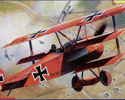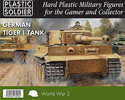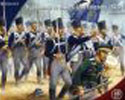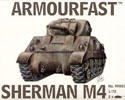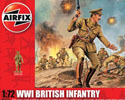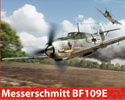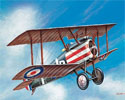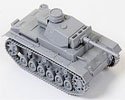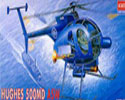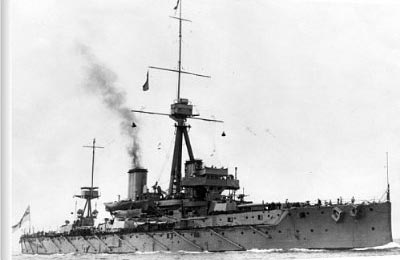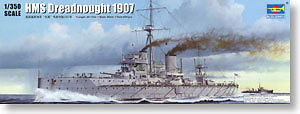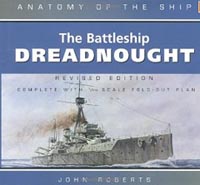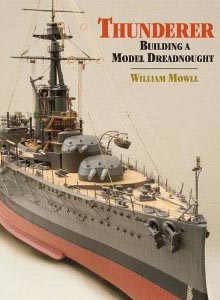The First World War - Dreadnought
HMS Dreadnought
On 10th February 1906, just 19 weeks after her keel had been laid; the hull of a new design of battleship was launched into the water by King Edward VII at Portsmouth dockyard. Her name was Dreadnought and she was destined to change the face of naval warfare almost overnight.
HMS Dreadnought was the brainchild of First Sea Lord, Admiral Sir John ‘Jackie’ Fisher. It represented a huge risk to the Royal Navy, which was not known for initiating ground-breaking changes because it had much to lose by making its vast fleet obsolete.
Fisher, however, saw that other countries, in particular the United States, Russia and Japan, were planning to adopt the concept of the ‘all big gun’ battleship and wanted to retain the dominant position enjoyed by the Royal Navy over its foreign competitors.
A further consideration was an improvement of build times by foreign shipyards that threatened to reduce Britain’s superior build rate over her potential opponents.
What Fisher had in mind was a revolutionary vessel, which could move faster and fire further than its enemy counterparts and could be built in a significantly shorter time than previous battleship designs.
Big Guns
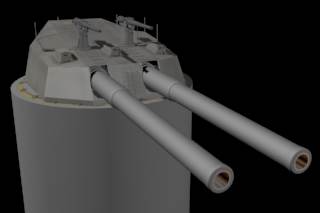
HMS Dreadnought - ten 12 inch main guns
housed in five traversable armoured turrets
Towards the end of the 19th Century the normal method of engagement was to line up the battle fleet alongside the opposing battle fleet and pound them with broadsides in a similar fashion to the wooden sailing ships of Nelson’s day a century before. Typically, because of difficulties in sighting and accuracy, this was at a range of around 1,800m (2,000 yards). The guns of the day had ranges well in excess of 1,800 m and experiments to increase the effectiveness of the guns at longer ranges were being conducted by the Royal Navy at the turn of the century.
One of the driving forces behind this tactical change was the emergence and rapid development of the torpedo, making it necessary to increase the engagement distance beyond the range of these new weapons.
One of the methods developed to permit this was called 'spotting', the homing in on the target by the observation of the fall of the shot. The problem was that battleships carried a very large assortment of different sizes of gun, all of which were likely to be firing at the same time; it was very difficult to identify which shot was from which gun and so virtually impossible to alter a particular gun’s elevation to close on the target. The answer to this was considered to be the adoption of a single type of main armament that could engage at long distance. This was to become the "All Big Gun" concept that Dreadnought was built to fulfil.
Dreadnought focused it's firepower on two calibres of gun: ten heavy weight 12 inch main guns mounted in five armoured traversable gun houses (turrets) to take on the opposing battleships, supported by 24 12lbr guns to engage closer targets like destroyers or torpedo craft.
By about 1903 effective engagement ranges had been increased to around 7,300m (8,000 yds) on an ideal day (clear and bright) through training and the adoption of ‘spotting’ and fire control systems.
Engines
Pre-Dreadnought battleships had used triple expansion reciprocating piston steam engines to drive them.
Dreadnought utilised steam turbines to propel her through the water, not really a new idea, as they had been used previously on destroyers and other small craft, but the scale was new, no other large ship had used turbines.
At 21 knots the turbines gave Dreadnought a speed advantage over the 18 knots of previous battleships.
This allowed Dreadnought to dictate the terms of the battle. Dreadnought could engage and disengage at will and, by moving ahead of her opponent, could steer in front, cross the ‘T’ and focus her broadside of eight main guns on the bow of the enemy vessel, which would only be able to respond with two guns in the front turret.
Turbines were about 100 tons lighter than the equivalent reciprocating machinery, allowing Dreadnought to incorporate more armour.
Build time
The speed at which Dreadnought was built was extraordinary for the time. Dreadnought was built at Portsmouth Dockyard in slightly over one year, half of what other shipyards would typically take to produce a ship of comparable size. At the time Portsmouth could outbuild any dockyard in the world. It was also familiar to Admiral Fisher, who had spent fourteen months there as commander-in-chief of the dock. Special care was taken in Dreadnought’s design to standardise on the parts and the number of types and thicknesses of plate were reduced in an effort to decrease production lead times and potential problems. At the height of production up to 3000 men were working on Dreadnought 11 hours a day six days a week. New production methods and procedures were developed to ensure that the right materials were available at the right time. Pre-fabricated parts were produced in parallel away from the dock, reducing assembly times.
Dreadnought was laid down on 2nd October 1905. Dreadnought was launched by King Edward VII on 10th February 1906. Dreadnought then began a phase of fitting out. Captain Bacon, who had been involved in the development of Dreadnought, became her first Captain on 2nd July, joining the ship on 1st September 1906, the date she was commissioned. Dreadnought then began a series of trials finally being completed and entering service with the fleet on 11th December 1906.
Service History
Dreadnought initially went on an experimental cruise to test the new technology and gain experience to aid future development of the class. Dreadnought sailed from Portsmouth on January 5th 1907 headed for Spain and Gibraltar, then to Sardinia, back to Gibraltar and then to Trinidad, arriving on 5th February. The crew was put through a series of extensive training exercises and trials; testing the engines, guns, torpedo nets and searchlights amongst other things. On returning to Portsmouth Captain Bacon submitted a report that drew attention to a few defects but otherwise was very favourable to the design.
Dreadnought was commissioned as flagship of the Home fleet and held the position until 1911. At the end of 1912 Dreadnought was flagship of the 4th Battle Squadron, serving with the Home Fleet and then the Grand Fleet. In 1916 Dreadnought was transferred to the 3rd Battle Squadron at Sheerness, returning to the 4th Battle Squadron at Scapa Flow in 1918.
Dreadnought never fired her main guns at an enemy ship and had a relatively quiet time during World War One. During the Battle of Jutland Dreadnought was undergoing a refit. Dreadnought saw action several times when she fired her AA guns at enemy aircraft raiding Chatham and London during 1917/1918. The only other time Dreadnought engaged the enemy was on 18th March 1915 when she rammed and sank a German Submarine, U29 commanded by Otto Weddigen, becoming the only battleship ever to have sunk a submarine.
At the end of the war Dreadnought was transferred to the Naval Reserve and on 31st March 1920 was sold as scrap for just under £45,000.
Other Dreadnought Battleships
Dreadnought was the only ship in her class but there were two other subsequent classes that followed the same basic arrangement.
The Bellerophon class consisted of three ships, laid down in1906-1907 and completed in 1909: HMS Bellerophon, Superb and Temeraire.
The St Vincent class consisted of three ships laid down in 1907-1908 and completed in 1909-1910: HMS St. Vincent, Vanguard and Collingwood.
Later classes had different arrangements and progressively changed the design until the introduction of the Orion class, which were known as Super-Dreadnoughts, having bigger guns all along the centre line with the rearmost fore and aft turrets in a super-firing arrangement firing over the top of the turret in front.
